| 2001 QUEENSLAND TERM POSTCARDS
MT COOT-THA: AUGUST 23, 2001
| INDEX |
PREV
| NEXT
|
Brisbane Forest Park is one of the largest and most accessible reserves of its
type close to a major city anywhere in the world. Starting at Mt Coot-tha, the
forest covers more than 28,000 hectares. The park provides a beautiful natural
backdrop to Brisbane and more than 2 million people visit the park annually.
Brisbane Forest Park is a large expanse of publicly held land
which includes National Parks,
picnic grounds and a water reservoir.
It stretches from within 7 kilometers of the heart of
Brisbane to a distance of about 40km away. As well as being
the site of several local television transmitters and communications
towers, Mt Coot-tha includes numerous picnic and other recreation
facilities and is the nearest part of Brisbane Forest Park to the city.
Mt Coot-tha has an elevation of 218m and
is a 10-minute drive west of the University of Queensland.
At the summit there is a souvenir shop, a restaurant and a
more casual cafe overlooking the city.
Coot-tha is an aboriginal word referring to the place of wild bees and
the small, black and stingless native bees Trigona are still
common in the area. There is a good view of the city of Brisbane
from the top of the mountain, and it is a popular place with young
people at night as the lights of Brisbane twinkle below!
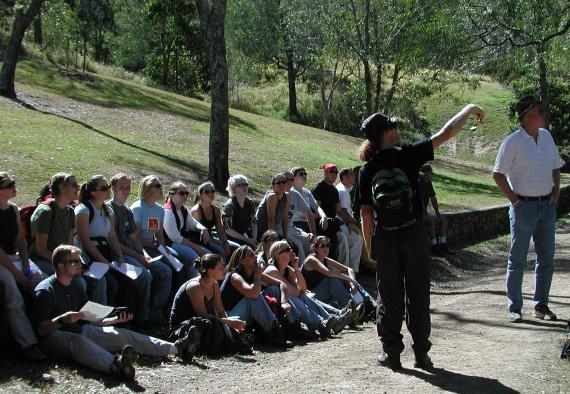 To help get acquainted with some of the environmental questions and field
techniques that would be important throughout the program, on the third
day of classes, there was a half-day field trip to
Brisbane Forest Park. Drs. Mike Pole and David Yates and honors student Boyd
Wright led the group through a series of discussions and data collection
exercises.
To help get acquainted with some of the environmental questions and field
techniques that would be important throughout the program, on the third
day of classes, there was a half-day field trip to
Brisbane Forest Park. Drs. Mike Pole and David Yates and honors student Boyd
Wright led the group through a series of discussions and data collection
exercises.
Here, Mike Pole from the University of Queensland discusses some issues concerning
various Australian vegetation types near Simpson's Falls in Brisbane Forest Park.
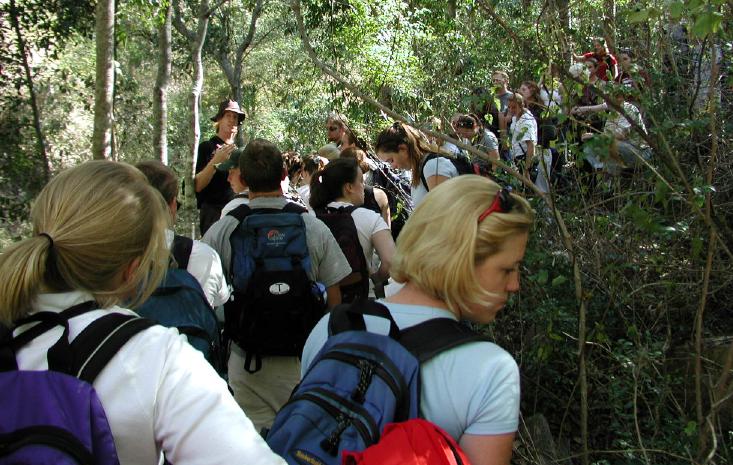 Most of our discussions were held trail-side. Here Mike Pole discusses the boundary between
some rainforest species and the more open eucalypt forest types.
Most of our discussions were held trail-side. Here Mike Pole discusses the boundary between
some rainforest species and the more open eucalypt forest types.
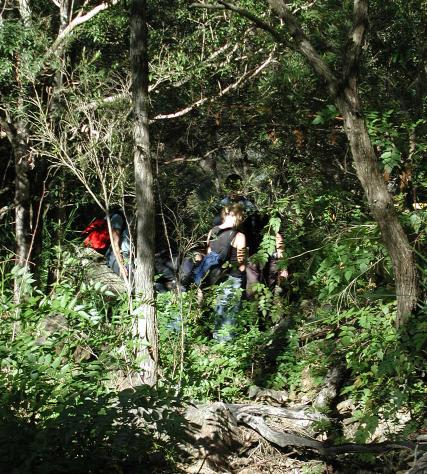
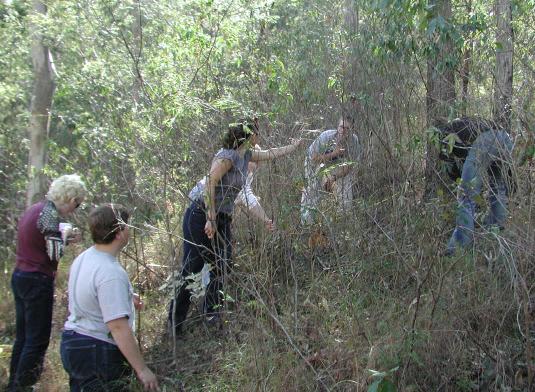
Collecting species area along a stream bed and on a drier hillside.
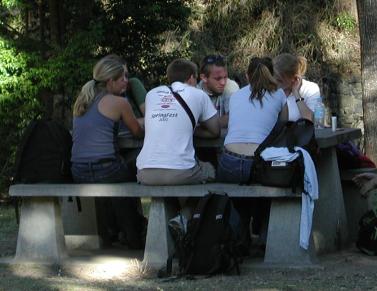 After the exercises were complete, there were small group discussions of projects
to be carried out either here or at Stradbroke Island based on the questions arising
from the day's activities.
After the exercises were complete, there were small group discussions of projects
to be carried out either here or at Stradbroke Island based on the questions arising
from the day's activities.
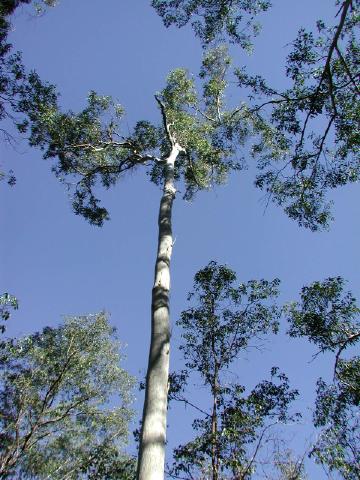 A typical eucalypt with its open canopy.
A typical eucalypt with its open canopy.
 Dacelo novaguineae, "Laughing Kookaburra"
Dacelo novaguineae, "Laughing Kookaburra"
Phylum: Chordata
Class: Aves
Family: Alcedinidae
The Laughing Kookaburra (Dacelo novaguineae) is the largest
kingfisher. They have a loud, maniacal laughing call and are often heard in
"chorus." They feed mainly on reptiles and large invertebrates. They are
common in woodlands and forests in eastern Australia and are often seen
in pairs.
Length: 46cm.
Other birds seen included Sulphur-Crested Cockatoos, Brush Turkeys, Noisy Miners, and Currawongs.
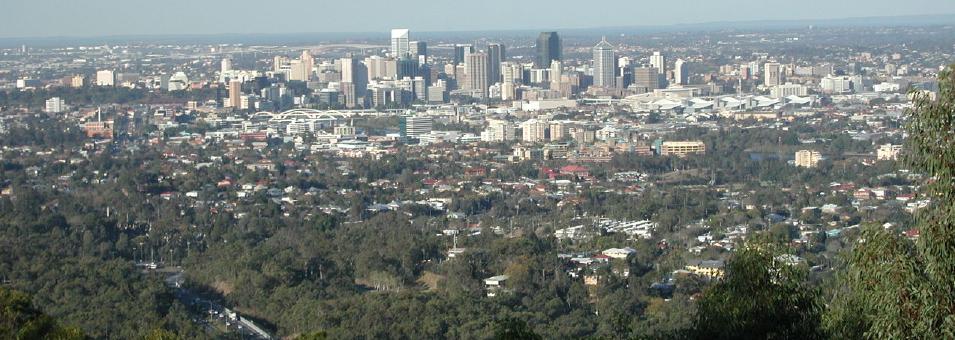
From the top of Mt. Coot-tha
on a clear day, you can see the distant line of Moreton and Stradbroke islands, the
Glasshouse Mountains to the north, the mountains behind the Gold Coast to the south.
There are several nice trails around Mt Coot-Tha and its foothills, such as
the one to JC Slaughter Falls starting on Simpson's Rd.
The Mt Coot-tha Botanic Gardens, at the
foot of the mountain, have an enclosed tropical dome, an arid zone,
rainforests, and a Japanese garden.
The Sir Thomas Brisbane Planetarium,
the largest in Australia, is also located in the Botanic Gardens.
Hobart & William Smith Colleges and Union College
Partnership for Global
Education: Queensland Term 2001
 To help get acquainted with some of the environmental questions and field
techniques that would be important throughout the program, on the third
day of classes, there was a half-day field trip to
Brisbane Forest Park. Drs. Mike Pole and David Yates and honors student Boyd
Wright led the group through a series of discussions and data collection
exercises.
To help get acquainted with some of the environmental questions and field
techniques that would be important throughout the program, on the third
day of classes, there was a half-day field trip to
Brisbane Forest Park. Drs. Mike Pole and David Yates and honors student Boyd
Wright led the group through a series of discussions and data collection
exercises. Most of our discussions were held trail-side. Here Mike Pole discusses the boundary between
some rainforest species and the more open eucalypt forest types.
Most of our discussions were held trail-side. Here Mike Pole discusses the boundary between
some rainforest species and the more open eucalypt forest types.

 After the exercises were complete, there were small group discussions of projects
to be carried out either here or at Stradbroke Island based on the questions arising
from the day's activities.
After the exercises were complete, there were small group discussions of projects
to be carried out either here or at Stradbroke Island based on the questions arising
from the day's activities. A typical eucalypt with its open canopy.
A typical eucalypt with its open canopy.
 Dacelo novaguineae, "Laughing Kookaburra"
Dacelo novaguineae, "Laughing Kookaburra"